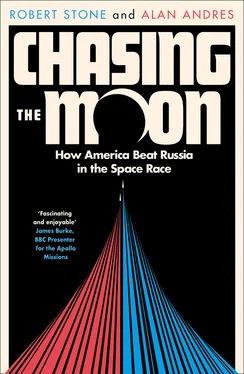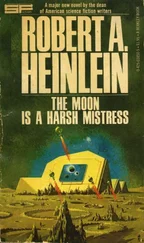Taking von Braun’s lead, Johnson forecast a sinister future vision that would delight the heart of a James Bond supervillain: “Control of space means control of the world,” he declared. “From space, the masters of infinity would have the power to control the Earth’s weather, to cause drought and flood, to change the tides and raise the levels of the sea, to divert the Gulf Stream and change temperate climates to frigid.”
Eisenhower scoffed at all the apocalyptic rhetoric, as well as at those who offered a variation on Fred Singer’s idea that the United States should respond to the Soviet Union’s presence in space by sending a rocket to the Moon armed with a warhead. In response, Eisenhower said he would rather have one nuclear-armed short-range Redstone rocket than an expensive and impractical moon rocket. “We have no enemies on the Moon,” he declared.
On Capitol Hill, Lyndon Johnson invited von Braun and General Medaris to testify before a Senate preparedness subcommittee inquiry. Johnson not only recieved the media exposure he desired, but the pair from Huntsville put the White House on the defensive with a few well-crafted lines for the newsreel and television cameras. “Unless we develop an engine with a million-pound thrust by 1961,” Medaris warned, “we will not be in space—we will be out of the race!” Von Braun raised the specter of a hammer and sickle hanging in the heavens, cautioning that the country was “in mortal danger” if the Soviets conquered space. “They consider the control of space around the Earth very much like, shall we say, the great maritime powers considered the control of the seas in the sixteenth through eighteenth centuries. And they say, ‘If we want to control this planet, we have to control the space around it.’ ”
The country heard them testify to how the Army’s readiness had fallen victim to petty armed-service rivalries, bureaucratic lassitude, and indecisiveness, a situation that Johnson called “nothing short of disgraceful.” Von Braun once again hypnotized the press, particularly a New York Times journalist who described him as a “blonde, broad shouldered and square-jawed … youthful-looking German scientist” who “drew many sympathetic laughs as he smilingly grappled with questions.”
The nation’s attempt to rid itself of Sputnik anxiety came on a morning in December 1957, barely two months after the shocking news from Moscow. Journalists at Cape Canaveral all had their binoculars focused on Launch Complex 18. There had been no official announcement, but word had spread among the newsmen that this was the likely day; sources at the local motels, restaurants, and bars all said something was being planned for that morning.
Shortly before noon on December 6, a cloud of white smoke appeared at the base of the U.S. Navy’s Vanguard rocket as it began to move upward into the sky. CBS News’s Harry Reasoner observed the launch from a privileged position on the porch of a nearby beach house. At the first sign of smoke he shouted, “There she goes!” His assistant, who was inside the house, on the phone with the network’s New York newsroom, immediately conveyed the word. Once the message had been received, Reasoner’s New York colleague promptly put down the phone to get the news on the air. But by that moment Reasoner was shouting, “Hold it! Hold it!” as he watched the Vanguard fall back on the pad and collapse into an expanding fireball, its tiny satellite toppling out of its nosecone. CBS had beaten ABC and NBC in broadcasting the news from the Cape but had incorrectly reported that the launch had gone well.
The shock of the failure was somewhat reduced by the fact that pictures of the explosion hadn’t been broadcast on live television. But the humiliating film of Vanguard’s end was shown repeatedly later in the day, often in slow motion. In the days that followed, the Air Force Missile Test Center chose to impose tighter media regulations, going so far as to prohibit binoculars and cameras on the nearby beaches.
In the wake of the failed launch, General Medaris and von Braun struggled to find their opportunity. Their Jupiter rocket, built in four stages so as to carry a satellite into orbit, was assembled later that month. But when it came to scheduling an available launch date at Cape Canaveral, the Huntsville team had to compete with their rivals, preparing a second Vanguard. The Navy rocket went through four different countdowns in January, but all were canceled due to technical difficulties or bad weather. The Army was alloted only three days —January 29, 30, and 31—to get Jupiter off the ground.
High winds canceled any possibility of a launch on the first two days, but at the last available opportunity, at 10:48 P.M. on January 31, 1958, Jupiter lifted off. NBC News used a motorcycle courier, a light airplane, and a police escort to rush their film of the launch to an affiliate station in Jacksonville, where it was processed and broadcast nationally within ninety minutes.
By the time the film was ready, von Braun, University of Iowa astrophysicist James Van Allen, and the Jet Propulsion Laboratory’s William Pickering were holding a midnight press conference in a small camera-packed room at the National Academy of Sciences in Washington. Pickering’s JPL, in Pasadena, had designed and built Jupiter’s payload, the Explorer 1 satellite; Van Allen was in charge of the United States’s International Geophysical Year satellite program. Basking in triumph before a bevy of reporters, the trio held above their heads a full-size replica of Explorer, in a pose that became an iconic press photo.
In Huntsville, few were watching television at that late hour. The town that had seen its population triple in the eight years since the Army brought its rocket-and-missile center to northern Alabama had informally renamed itself “the Rocket City.” Led by a call from its mayor broadcast over the local radio station, Huntsville’s police sounded squad-car sirens and honked horns as citizens gathered downtown to celebrate with cheers of vindication and jubilation. Close to midnight, thousands gathered in the town’s Courthouse Square, which had been watched over by a granite statue of a Confederate soldier since 1905, erected and dedicated a few months after a notorious lynching on the same spot. The crowd held signs reading SHOOT FOR MARS!, OUR MISSILES NEVER MISS!, and MOVE OVER MUTTNIK!

© NASA/Marshall Space Flight Center
The Jet Propulsion Laboratory’s William Pickering, physicist James Van Allen of the University of Iowa, and Wernher von Braun celebrate the launch of Explorer I, the first American satellite, at their midnight press conference in Washington, D.C., on January 31, 1958.
The mayor joined the rowdy celebration, lighting skyrockets and ducking exploding firecrackers. A Life magazine photographer pointed his Speed Graphic camera at the gleeful crowd, which hoisted high an effigy of former defense secretary Charles Wilson; images with unsettling reminders of the town’s past. After his 1956 memo restricting the Army’s missile program, Wilson had become the most hated man in Huntsville, and he was now widely blamed for allowing the Soviets to be first in space. As the effigy was torched, the revelers waved American and Confederate flags and shouted, “The South did rise again!”
Von Braun was the man of the moment. His face was on the covers of Time and Der Spiegel. Eisenhower invited him to a White House state dinner. When he appeared in Washington, overflow crowds of journalists and photographers would attend, yet never were there any questions about his war years. Congressmen requested that he pose for photographs with members of their family. As a Capitol Hill session on space appropriations was breaking up, one congressman was even heard asking, “Dr. von Braun, do you need any more money?”
Читать дальше













